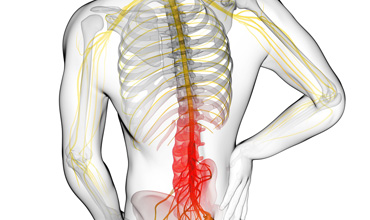Lumbar Radiculopathy: Results of Grade 3 And 4 Vertical Oscillatory Pressure (VOP) In Pain Management In A 32-Year-Old Female. A Case Report

Abstract:
Chronic
low back pain is prevalent in the western world. Lumbar radiculopathy is a common
presentation in physical therapy daily practice.4
Large epidemiological studies show that: “20 to 30% of patients with chronic back
pain suffer from a neuropathic pain component”.4,7 Its diagnosis and
management remain an enigma. There is no conclusive evidence for the long-term efficacy
of spinal manipulation for any type of low back pain.3 There is no evidence
that describes the efficacy of vertical oscillatory pressure (VOP) in the management
of pain resulting from lumbar radiculopathy either. The few articles that report
the effect of VOP did not quantify the intensity (grading) of the applied thrust
to the spine.3 This case report describes and observe the result of applying
a submaximal and maximal central posterior-anterior thrust (grade 3 and 4) vertical
oscillatory pressure to the lumbar spine in a 32-year-old female with lumbar radiculopathy.
In his prospective study, Onuwe observed a statistically significant difference
in pain perception before and after vertebral mobilization.13 The purpose
of this case report was to describe and observe the result of VOP in pain management
of a 32-year-old female with lumbar radiculopathy.
References:
1. Boonstra
AM, Schiphorst Preuper HR, Reneman MF, Posthumus JB, Stewart RE. Reliability and
validity of the visual analog scale for disability in patients with chronic musculoskeletal
pain. Int J Rehabil Res. 2008; 31(2):
165-9. http://www.ncbi.nlm.nih.gov/pubmed/1846793. Accessed November 19, 2012.
2. Briggs
DR. The Straight Leg Raise Test. Dynamic Chiropractic.
2012; 30(23). http://www.dynamicchiropractic.com/mpacms. Accessed November 2,
2012.
3. Bronfort
G. Spinal Manipulation: Current State of Reasearch and its indications. 1999;
17(1): 91-111.doi: 10.1016/s0733-8619(05) 70116-x
4. Colloca
CJ, Keller TS, Gunzburg R. Biomechanical and neurophysiological responses to spinal
manipulation in patients with lumbar radiculopathy. Journal of Manipulation and Physiological Therapeutics. 2004;
27(1);1-15. Doi: 10.101b/j.jmpt.2003.11.021.
5. Cox
JM, Davison A. The visual analog scale as a tool for self-reporting of subjective
phenomena in the medical radiation sciences. Education Today. 2012; 12(3). http://www.minniscomms.com.au/educationto.
Accessed October 30, 2012.
6. Einhaupl
KM, Failli V, Klingebiel R, Pruss H, Schwab JM, Siebert E. Lumbar spinal stenosis:
Syndrome, diagnostics and treatments. Nature
Reviews Neurology. 2009; 5(7): 392. Doi: 10.1038/nrneurol.2009.90
7. Freynhagen
R, Baron R. The evaluation of neuropathic components in low back pain. Current Pain and Headache Reports.
2009;13(3): 185-190. Doi: 10.1007/s11916-009-0032-y.
8. Goodman
CC, Synder TEK. Differential Diagnosis for Physical Therapists: Screening for Referral.
St. Louis, Missouri: Sanders Elsevier, 2007.
9. Hall
SJ. Fundamentals of Maitland Mobilizations. Morphopedics.
http://morphopedics.wikidot.com/fundamentals. Accessed September 30, 2012.
10. Leininger
B, Bronfort G, Evans R, Reiter T. Spinal manipulation or mobilization for radiculopathy:
a systematic review. Phys Med Rehabil Clin
N Am. 2011; 22(1); 105-25. http://www.ncbi.nlm-nih.gov/pubmed/2129214. Epubished
30 December 2010. Accessed November 30 2012.
11. Maitland
GD. Maitland’s Vertebral Manipulation. 7th ed. Philadelphia, PA: Elsevier;
2005.
12. Moore
KL, Dally AF. Clinically Oriented Anatomy. 5TH edition. Baltimore: Lippincolt
Williams & Wilkins; 2006.
13. Onuwe
HAK. Relative therapeutic efficiency of vertebrae mobilization technique in the
management of mechanical low back pain. Journal
of Medicine in the Tropics. 2004: 6(2).
14. Oswestry
Disability Index: Version 2.0. http://www.chirogeek.com/001_oswestry_20.htm.
Accessed September 21, 2012.
15. Rabin
A, gerszten PC, Karausky P, Bunker CH, Potter DM, Welch WC. The sensitivity of the
seated staright-leg raise test compared with the supine straight-leg raise test
in patients presenting with magnetic resonance imaging evidence of lumbar nerve
root compression. Arch Phys Med Rehabil. 2007;
88(7):840-3. http://www.ncbi.nlm.nih.gov/pubmed/1760146. Accessed October 25, 2012.
16. Rehab
Students. Straight Leg Raise (SLR) Test. http://videos.rehabstudents.com/straight-leg-ra.
Updated April 10, 2010. Accessed November 10, 2012.
17. Sheffinger
MA, Najim WI, Mishra SI. Reliability of Spinal Palpation for Diagnosis of Back and
Neck Pain: A Systematic Review of the Literature. Spine. 2004; 29(19): 413-425. http://www.westrenupatientcarecenter.com/bin/.
Accessed November 3, 2012.
18. Sipila
VP. The Rationale for Joint Mobilization as a Manual Technique. http://www.orthosportonline.com/veli-s-Corne.
Accessed November 19, 2012.
19. Sizer
PS jr, Phelps V, Matthijs O. Pain Generators of the Lumbar Spine. Pain Practice. 2001; 1(3):
255-273.doi:10.1111/j.1533-2500.2001.01027.x

